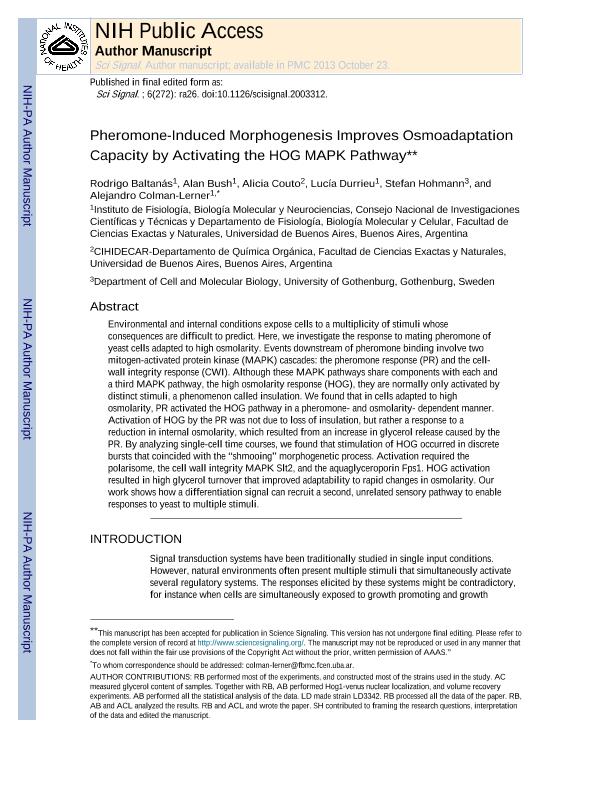Mostrar el registro sencillo del ítem
dc.contributor.author
Baltanas, Rodrigo

dc.contributor.author
Bush, Alan

dc.contributor.author
Couto, Alicia Susana

dc.contributor.author
Durrieu, Lucía

dc.contributor.author
Hohmann, Stefan
dc.contributor.author
Colman Lerner, Alejandro Ariel

dc.date.available
2015-09-28T19:44:13Z
dc.date.issued
2013-04
dc.identifier.citation
Baltanas, Rodrigo; Bush, Alan; Couto, Alicia Susana; Durrieu, Lucía; Hohmann, Stefan; et al.; Pheromone-induced morphogenesis improves osmoadaptation capacity by activating the HOG MAPK pathway; American Association for the Advancement of Science; Science Signaling; 6; 272; 4-2013; ra26
dc.identifier.issn
1937-9145
dc.identifier.uri
http://hdl.handle.net/11336/2164
dc.description.abstract
Environmental and internal conditions expose cells to a multiplicity of stimuli whose consequences are difficult to predict. We investigate the response to mating pheromone of yeast cells adapted to high osmolarity. Events downstream of pheromone binding involve two mitogen-activated protein kinase (MAPK) cascades: the pheromone response (PR) and the cell wall integrity (CWI) response. Although the PR MAPK pathway shares components with a third MAPK pathway, the high osmolarity (HOG) response, each one is normally only activated by its cognate stimulus, a phenomenon called insulation. We found that in cells adapted to high osmolarity, PR activated the HOG pathway in a pheromone- and osmolarity-dependent manner. Activation of HOG by the PR was not due to loss of insulation, but rather a response to a reduction in internal osmolarity, which resulted from an increase in glycerol release caused by the PR. By analyzing single-cell time courses, we found that stimulation of HOG occurred in discrete bursts that coincided with the "shmooing" morphogenetic process. Activation required the polarisome, the CWI MAPK Slt2, and the aquaglyceroporin Fps1. HOG activation resulted in high glycerol turnover, which improved adaptability to rapid changes in osmolarity. Our work shows how a differentiation signal can recruit a second, unrelated sensory pathway to fine-tune yeast response in a complex environment.
dc.format
application/pdf
dc.language.iso
eng
dc.publisher
American Association for the Advancement of Science

dc.rights
info:eu-repo/semantics/openAccess
dc.rights.uri
https://creativecommons.org/licenses/by-nc-sa/2.5/ar/
dc.subject
Signal Transdunction
dc.subject
Mapk
dc.subject
Stress
dc.subject
Cross-Talk
dc.subject.classification
Biología Celular, Microbiología

dc.subject.classification
Ciencias Biológicas

dc.subject.classification
CIENCIAS NATURALES Y EXACTAS

dc.title
Pheromone-induced morphogenesis improves osmoadaptation capacity by activating the HOG MAPK pathway
dc.type
info:eu-repo/semantics/article
dc.type
info:ar-repo/semantics/artículo
dc.type
info:eu-repo/semantics/publishedVersion
dc.date.updated
2016-03-30 10:35:44.97925-03
dc.journal.volume
6
dc.journal.number
272
dc.journal.pagination
ra26
dc.journal.pais
Estados Unidos

dc.journal.ciudad
Nueva York
dc.description.fil
Fil: Baltanas, Rodrigo. Consejo Nacional de Investigaciones Científicas y Técnicas . Oficina de Coordinación Administrativa Ciudad Universitaria. Instituto de Fisiología, Biología Molecular y Neurociencias; Argentina. Universidad de Buenos Aires. Facultad de Ciencias Exactas y Naturales; Argentina
dc.description.fil
Fil: Bush, Alan. Consejo Nacional de Investigaciones Científicas y Técnicas . Oficina de Coordinación Administrativa Ciudad Universitaria. Instituto de Fisiología, Biología Molecular y Neurociencias; Argentina
dc.description.fil
Fil: Couto, Alicia Susana. Consejo Nacional de Investigaciones Científicas y Técnicas. Oficina de Coordinación Administrativa Ciudad Universitaria. Centro de Investigaciones en Hidratos de Carbono; Argentina
dc.description.fil
Fil: Durrieu, Lucía. Consejo Nacional de Investigaciones Científicas y Técnicas . Oficina de Coordinación Administrativa Ciudad Universitaria. Instituto de Fisiología, Biología Molecular y Neurociencias; Argentina
dc.description.fil
Fil: Hohmann, Stefan. University of Gothenburg. Department of Cell and Molecular Biology; Suecia
dc.description.fil
Fil: Colman Lerner, Alejandro Ariel. Consejo Nacional de Investigaciones Científicas y Técnicas . Oficina de Coordinación Administrativa Ciudad Universitaria. Instituto de Fisiología, Biología Molecular y Neurociencias; Argentina
dc.journal.title
Science Signaling

dc.relation.alternativeid
info:eu-repo/semantics/altIdentifier/doi/http://dx.doi.org/DOI:10.1126/scisignal.2003312
dc.relation.alternativeid
info:eu-repo/semantics/altIdentifier/url/http://stke.sciencemag.org/content/6/272/ra26
Archivos asociados
